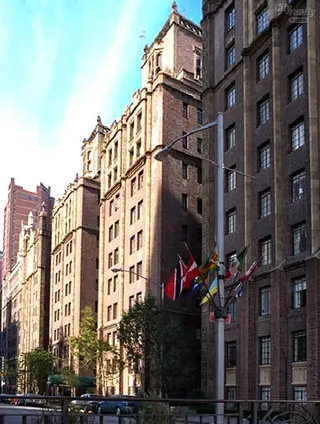 Carter Horsley
Carter HorsleyDec 23, 2011
Carter's Review
This distinguished, 10-story, cooperative apartment building was erected in 1927 and was converted to a cooperative in 1988. It has 215 apartments and is part of the Tudor City complex developed by Fred F. French and is within the Tudor City Historic District.
The red-brick structure has extensive Tudor-style façade decoration and in 2001 its façade, which has three light-wells and two towers, was cleaned. It has a canopied, one-step-down entrance.
The building is close to the nice, large park at Tudor City and close to the Ford Foundation Building across the street. It is just to the east of the Permanent Mission of Malaysia to the United Nations and a block to the west is the very impressive Permanent Mission of India to the United Nations that was designed by Charles Correr and Bond Ryder.
This building has consistent, multipaned fenestration and sidewalk landscaping. It has a concierge and a Tudor-style lobby with wood entrance doors. It also has a gym and a roof deck and some penthouse terraces.
This street is also known as UN Way and has handsome light stanchions with flags with views of the Secretariat Building of the United Nations to the east and the Chrysler Building to the west.
There is excellent cross-town bus service on 42nd Street although subways are not too close. There are numerous restaurants in the area, which have good architecture mingled in with a number of former industrial buildings and postwar office buildings.
The building has ground-floor commercial space.
The Tudor City complex, which its developer called "a city within a city," was created by Fred Fillmore French starting in 1925 when he assembled six blockfronts along Prospect Place, a small north-south street west of First Avenue that was lined most with brownstones.
According to a May 15, 1994 article by Christopher Gray in The New York Times, Mr. French had previously erected some luxury residential buildings such as 1140 Fifth Avenue "where he built a squash court into his own roof duplex and then 1010 Fifth Avenue, at 82nd Street, where he occupied the penthouse apartment with a huge roof garden."
"By 1927 he began construction on the largest single residential project New York had yet seen. By 1932 he had finished nine big apartment houses and a hotel with a total of 2,800 units that soon accommodated 4,500 residents," according to Mr. Gray.
The enclave surrounds two gardens on either side on the bluff at the end of 42nd Street.
According to Mr. Gray's article, the south garden was at first a miniaturized 18-hole golf course and "around 1950, 42nd Street was widened to produce a near-boulevard leading to the United Nations, over the protests of the French Company" and "at that time the parks were narrowed and redesigned by J. J. Levison, a landscaped designer who denatured them by removing most of their English-style accessories."
Harry B. Helmsley acquired the complex in 1970 and announced plans to build two apartment buildings on the site of the gardens, setting off a long controversy when a court ruled against the proposal.
The Landmarks Preservation Commission designated the complex and the gardens a landmark in 1988 after a coop conversion of most of the buildings by Francis Greenberger and Philip Pilevsky.
The area was once dominated by tenements near a power plant and slaughterhouses along the river and was known as "Goat Hill" and later "Prospect Hill" and then "Corcoran s Roost." Eventually it became known as a haven for waterfront thieves including the Rag Gang in the late 19th Century.
The buildings along Prospect Place have very few windows that face east because of the stench of the slaughterhouses and the lack of architectural distinction across the East River. The views that face west, however, boast spectacular vistas of midtown.
In a May 13, 1988 article in The New York Times David W. Dunlap observed that the complex consisted of "rather simple brick apartment buildings to which an exuberant profusion of limestone ornament was applied top and bottom - the Tudor rose and heraldic arms, portcullises, griffins and boar's heads" and quoted Anne Lowenstein, the co-chairman of the Historic Preservation Committee of the Tudor City Association as claiming that "the embellishments are so humanizing," adding that "they bring it down too a human scale and give it a warmth and character."
"Between the decorative elements, otherwise simple walls were animated by multiple-pane casement windows and expanses of leaded and stained glass, many contained within complex and delicate traceries," Mr. Dunlap wrote, reporting that the landmarks commission had declared the complex a landmark by a vote of 8 to 0.
Mr. Dunlap said that the complex was built under the supervision of the architect H. Douglas Ives.
Tudor Tower at 25 Tudor City Place and Prospect Tower at 45 Tudor City Place are both 22 stories tall. Hatfield House at 304 West 41st Street is 15 stories tall. Hardwick Hall at 314 East 41st Street, Haddon Hall at 324 East 41st Street, Essex House at 325 East 41st Street, The Cloister at 321 East 43rd Street, the Manor at 333 East 43rd Street and The Hermitage at 330 East 43rd Street are 11 stories tall.
Windsor tower, which has 799 apartments, is 25 stories high.
The tallest building in the complex is Woodstock Tower at 328 East 42nd Street which is 32 stories tall.

- Co-op built in 1923
- 6 apartments currently for sale ($299K to $749K)
- 1 apartment currently for rent ($3.9K)
- Located in Turtle Bay/United Nations
- 217 total apartments 217 total apartments
- 10 recent sales ($253.5K to $990K)
- Doorman
- Small Pets Allowed only
 6sqft delivers the latest on real estate, architecture, and design, straight from New York City.
6sqft delivers the latest on real estate, architecture, and design, straight from New York City.
